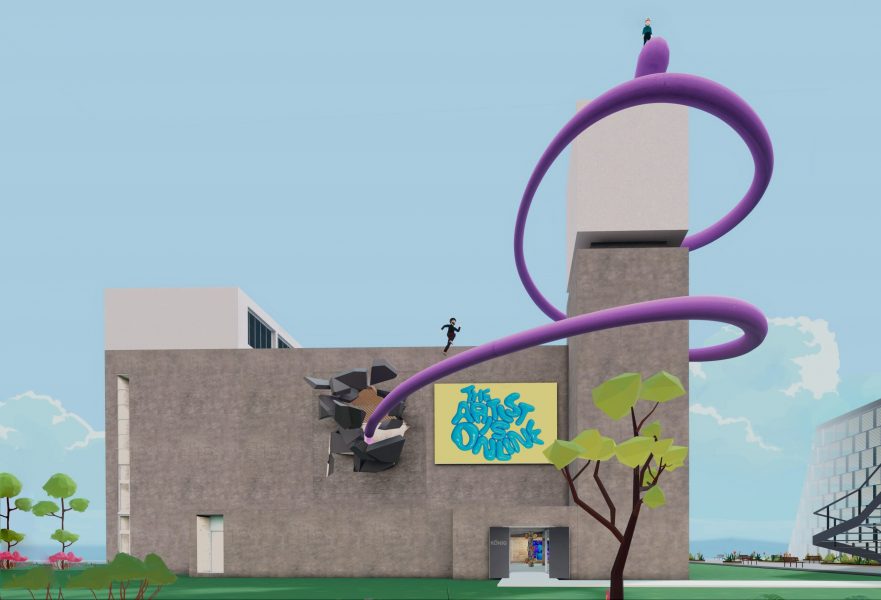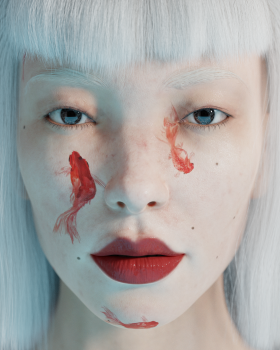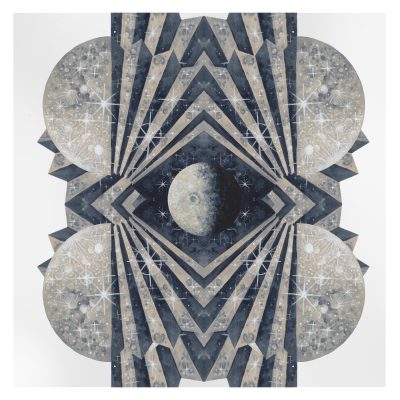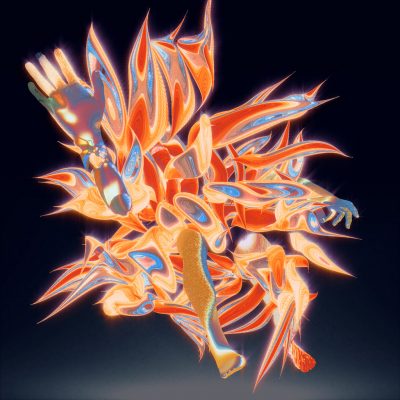NEW MEDIA: SOUTHEAST ASIA’S RESPONSE TO THE BLOCKCHAIN ENVIRONMENT
A look at Southeast Asia's growing engagement with on-chain art, generative art, AI, and conceptual works that innovate with blockchain or smart contracts.
By Clara Che Wei Peh

Installation view: The Artist is Online. Digital Paintings and Sculptures in a Virtual World, KÖNIG GALERIE, Decentraland, 2021.
Image courtesy of KÖNIG GALERIE Berlin, London, Seoul.
The ideological seeds behind non-fungible tokens emerged to address a long struggle for claiming ownership and uniqueness over digital artworks.
Digital art has been around since the 1960s, and artists working with digital mediums have long struggled to claim ownership and uniqueness over digital artworks. The ideological seeds behind non-fungible tokens (NFTs) emerged to address such issues, when entrepreneur and blogger Anil Dash and artist Kevin McCoy first introduced the idea of monetised graphics at the Seven on Seven Conference held at the New Museum in 2014. In 2017 and 2018, CryptoPunks, a collection of exactly 10,000 generated pixel-style icons developed by Larva Labs, and CryptoKitties, a breeding and collecting blockchain game by DapperLabs, presented early use-cases of NFTs and garnered widespread attention towards the crytographic tokens’ possibilities. But it was only this year, that NFTs fully invaded art world’s consciousness, catalysing unprecedented interests in artistic experiments on and around the blockchain, prompting a paradigm shift within the digital creative economy.
NFTs are unique digital assets encoded with smart contracts, stored on a decentralised ledger known as the blockchain. NFTs have been compared to digital proofs of authenticity and provenance that are transparent and traceable on the blockchain.
In March, an NFT of Beeple’s Everydays: The First 5000 Days was auctioned for 69 million USD at Christie’s. The auction house reported that over 90% of buyers registered for the sale were new to Christie’s, signalling the artist and NFTs’ ability to draw in collectors new to this corner of the art world. After the sale, Sotheby’s followed closely with Pak’s The Fungible Collection, while Phillips offered Mad Dog Jones’ REPLICATOR. Auction houses have rapidly continued to integrate NFTs into their sales calendars, with Christie’s staging “Proof of Sovereignty” curated by Lady Phe0nix and Sotheby’s presenting “Natively Digital” in collaboration with Robert Alice. Both auctions placed the likes of the estates of contemporary art icons Andy Warhol and Nam June Paik, and conceptual artist Jenny Holzer alongside popular digital artists lesser known to the contemporary art scene, such as Josie Bellini and Coin Artist, prompting conversations around the developments of digital art. Simultaneously, exhibitions such as “Virtual Niche – Have you ever seen memes in the mirror” held at UCCA Lab in Beijing, “Breadcrumbs” at Galerie Nagel Draxler in Cologne and KÖNIG GALERIE’s “The Artist is Online. Digital Paintings and Sculptures in a Virtual World” staged in Decentraland, a blockchain-based virtual world, further propelled considerations around NFTs’ place in the wider art ecosystem.
NFTs are unique digital assets encoded with smart contracts, stored on a decentralised ledger known as the blockchain. The NFT keeps track of interactions made onto the token, recording the original creator, bids and transactional movements of the token, as well as the wallet addresses from which these actions originate. NFTs have been compared to digital proofs of authenticity and provenance that are transparent and traceable on the blockchain.
Beyond building a purely digital experience, artists are also exploring how the intangibility of NFTs can complement their physical practice.
Singaporean artist, Yanyun Chen, shares that, “the biggest issue with digital works is the ease of duplication and digital theft, as well as the difficulties in tracking where the versions may have been copied if they are.” To mitigate this challenge, Chen and Alex Scollay, another Singapore-based artist, created individual versions for each of the 10 editions of their 5-minute animation video, The Truth Lies in Fact (2019), with an individual slate and edition number embedded in each video. Each edition was stored on an SD card and thumb-drive, accompanied by a handmade box for storage. Many other digital artists adopt a similar process to protect the scarcity of original artworks over the infinite shareability of digital objects. With the advent of NFTs, artists are presented with a new possibility.


L: Shavonne Wong, Lunah Moon I, 2021, Non-Fungible Token (3D Rendering, Still image.) R: Shavonne Wong‘s work-in-progress documentation, 2021.
Image courtesy of the artist.
Looking at Southeast Asia, a growing number of artists are beginning to adopt the use of NFTs. Terry Lee of Art Seasons Gallery, notes that, “NFTs provide artists with more direct sale platforms, which some find difficult to access through the traditional gallery route,” allowing artists to connect with new audiences, and creatives across the board to generate independent sources of income. Furthermore, Singapore photographer and virtual modelling agency creator, Shavonne Wong, takes NFTs as an opportunity for her to realise her own visions. In her decade-long photography career, Wong produced works with commercial clients in mind but had never been paid for personal work. “NFTs have given me a space where I can truly do what I want, with no outside direction. It is a very freeing experiencing,” shares Wong.

Arabelle Zhuang, Skinfolk Kinfolk, 2021, generative adversarial network imaging.
Image courtesy of the artist.
Fussner adds, “there is growing sophistication in appreciation towards on-chain art, generative art, AI and conceptual works that innovate with blockchain or smart contracts.”
Artists working with digital mediums are particularly drawn to the use of NFTs, as they provide a native experience for viewing and collecting digital artworks. Singaporean artist, Arabelle Zhuang, created an NFT of an image produced through a generative adversarial network (GAN) model. This NFT belongs to an ongoing series, Skinfolk, Kinfolk(2021), where Zhuang trains a GAN model with images taken from her family’s archive, to facilitate a meditation on her relationship with the women in her family.

Ernest Wu, Loading Loading, 2021, gif.
Image courtesy of the artist.
Ernest Wu, Singapore-based artist, is similarly interested in how NFTs interact with the perception of images in the digital realm. His genesis NFT series, It begins with a single block (2021) addresses the challenges of maintaining consistent colour conditions on different screens and monitors and how the same image – or a single block of colour – may be received differently by each of us. He continues this investigation in Loading Loading (2021 – ongoing), a series of GIFs that mimic loading images.

Radhinal Indra, Deforming No 5, 2021, digital imaging 1200 x 1200 pxl.
Image courtesy of the artist.
Beyond building a purely digital experience, artists are also exploring how the intangibility of NFTs can complement their physical practice. Indonesian painter, Radhinal Indra, comes from a graphic design background. He works closely with digital processes, often conceptualising his paintings by simulating images on digital softwares before working on a physical canvas. Previously, his digital works and 3D files have largely been kept as sketches. “With NFTs, there is a greater chance to explore the digital approach I integrate in my process and to show more of my works in motion graphics,” says Indra. He adds that, “NFTs are one of the many ways to explore my artistic vision, and I will continue to mint NFTs as I will continue to make physical artworks.”
In tandem to artists pioneering experimentations with NFTs, cultural workers and researchers are drawing lessons from blockchain technologies to re-conceptualise and reinvent modes of artistic production and management.
Meanwhile, Malaysian artist, Chong Yan Chuah, experiments with the token’s ability to establish ownership in comparison to a paper certificate of authenticity. Trained as an architect and keenly interested in virtual world-building, Chuah’s practice sits at the intersection of physical and fictional digital environments. His recent exhibition “FAC3D” at The Back Room in Kuala Lumpur, saw an in-person exhibition paired with an interactive online site, combining technology, literature and art. Chuah extends this multidimensional exploration into the realm of NFTs with a video of one of his AI avatars playing on-loop. The NFT includes unlockable content to exclusive for its collectors: an edition of the digital artwork on a hard-drive, as well as a physical certificate of authenticity, playfully challenging the uses and limits of the technology it makes use of.
In tandem to artists pioneering experimentations with NFTs, cultural workers and researchers are drawing lessons from blockchain technologies to re-conceptualise and reinvent modes of artistic production and management. Chris Fussner, co-founder of Tropical Futures Institute, a Philippines-based multi-disciplinary studio, has been researching and participating in the crypto ecosystem since 2013. Working across the art and blockchain worlds, Fussner suggests that NFTs and other Decentralised Finance (DeFi) innovations may propose foundational changes to artworld infrastructure, as adoption of models such as Decentralised Autonomous Organisations (DAOs) grow across artist collectives and collectors. A DAO enables each participating individual to interact according to a set of protocols encoded through smart contracts, encouraging equal distributions of power and rights while facilitating collaborative decision-making. Fussner shares that the Institute is currently supporting an arts DAO project, with the primary aim of creating economic support and value for creators. Fussner adds, “there is growing sophistication in appreciation towards on-chain art, generative art, AI and conceptual works that innovate with blockchain or smart contracts,” including artists like Harm van den Dorpel and on-going project, terra0.
Art galleries have also begun to enter the realm of NFTs to support this rapidly evolving climate. KÖNIG GALERIE’s “The Artist is Online. Digital Paintings and Sculptures in a Virtual World” was accompanied by the gallery’s first NFT auction of 29 digital artworks on the marketplace, OpenSea. Johann König, founder of the gallery, sees this is an opportunity to “[adapt] to this new environment and the habits of NFT collectors, who value transparency in regard to price and ownership.” Katharina Grosse, known for her large-scale paintings and sculptures, has been working with 3D scanning to produce digital interactive sculptural objects. König shares that the gallery is currently working with Grosse to release an NFT, in partnership with Freunde der Nationalgalerie; its proceeds will support the institution in acquiring works for its permanent collection. While Art Seasons Gallery has yet to officially release any NFTs for its artists, Lee says that an increasing number of galleries will embrace NFTs, with more galleries to present their artworks both physically and as NFTs. He remarks that we have barely scratched the surface, adding that “NFTs will play an increasingly important role in the visual art market and an essential part in the visual art cultures and histories for years to come.”
“We are seeing an increasing trend of crypto art bridging into the traditional art world, and contemporary artists beginning to mint NFTs,” said Gabby Dizon, co-owner of Narra Gallery.
On the other side of the equation, collectors are slowly, but surely, warming up to the emergence of NFTs, especially those who are already familiar with Web3 and the crypto economy. Colin Goltra and Gabby Dizon both started out as avid collectors of crypto art and NFTs, then came together to establish Narra Gallery, a gallery in the metaverse that focuses on the works of Southeast Asian artists. The gallery showcases Goltra and Dizon’s private collections and collaborates with artists on curated releases. The pair also started First Mint Fund, as they noticed “a growing disconnect between digital artists that were part of the crypto art and NFT community, and those who wanted to get in but did not know how to.” The Fund is currently managed by AJ Dimarucot, a well-known member of the Filipino digital art community, and distributes funds to support Southeast Asian artists in paying gas fees needed to upload their first NFTs. Dizon remarks that, “we are seeing an increasing trend of crypto art bridging into the traditional art world, and contemporary artists beginning to mint NFTs.” Simultaneously, NFT collectors are also expanding their collection into the traditional art world, notably with Justin Sun, Founder of the cryptocurrency platform TRON, purchasing Picasso and Warhol works at auction.

Tristan Lim, TNE_Figure#01, 2021, Non-Fungible Token (MP4.)
Image courtesy of the artist.
In Statista’s 2020 Global Consumer Survey, Vietnam and the Philippines ranked second and third in highest rates of cryptocurrency use amongst 74 countries surveyed.
Coupled with initiatives like Narra Gallery and the First Mint Fund, the Southeast Asian region is also seeing increased adoptions of cryptocurrencies. In Statista’s 2020 Global Consumer Survey, Vietnam and the Philippines ranked second and third in highest rates of cryptocurrency use amongst 74 countries surveyed. The region is also home to thriving blockchain start-ups and innovations, encouraged by welcoming governments. Yield Guild Games’ “Play-to-Earn” model allows players of NFT-based game, Axie Infinity (founded in Vietnam), to earn alternative income through breeding and trading digital pets. Axie Infinity has been reported to generate life-changing income for low-wage earners in the rural Philippines. Furthermore, the region is home to some notable NFT collectors, including Singapore-based Vignesh Sundaresan (or MetaKovan), the buyer of Beeple’s Everydays: The First 5000 Days, and Malaysia-based Sina Estavi, who purchased Twitter’s first tweet as an NFT for 2.9 million USD.
Mere months have passed since NFTs’ memorable introduction to the art world at Christie’s Beeple sale, but artists, gallerists and collectors are already looking ahead as to how the technology will continuously integrate into their practices. Singaporean artist, Tristan Lim, adds that “NFTs have resulted in a shift in people’s perception and understanding of value in digital art,” drawing attention towards previously overlooked genres such as cyberpunk. NFT skeptics and enthusiasts alike speculate on the future of NFTs, as many point out, despite its rapid growth and adoption, the NFT ecosystem is only at its infancy. Fussner suggests that this early-stage timing exactly presents an opportunity to experiment and innovate. “Look at this moment with NFTs as a special time to try out new technology in its nascency. You might stick around, and even if you do not, you would have participated in a very specific art and tech moment that will be remembered historically.”
ABOUT THE AUTHOR: CLARA CHE WEI PEH
Clara Che Wei Peh is an arts writer and researcher based in Singapore. She completed her BA in Economics at Yale-NUS College and MA in History of Art at the Courtauld Institute of Art. She has held positions at Christie’s New York, the 58th Venice Biennale, and most recently, NTU Centre for Contemporary Art Singapore. She lectures at LASALLE College of the Arts.
